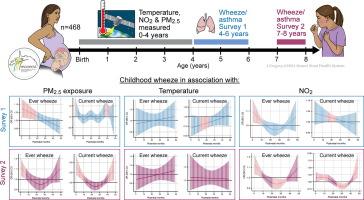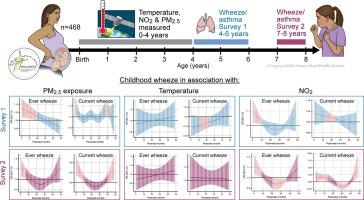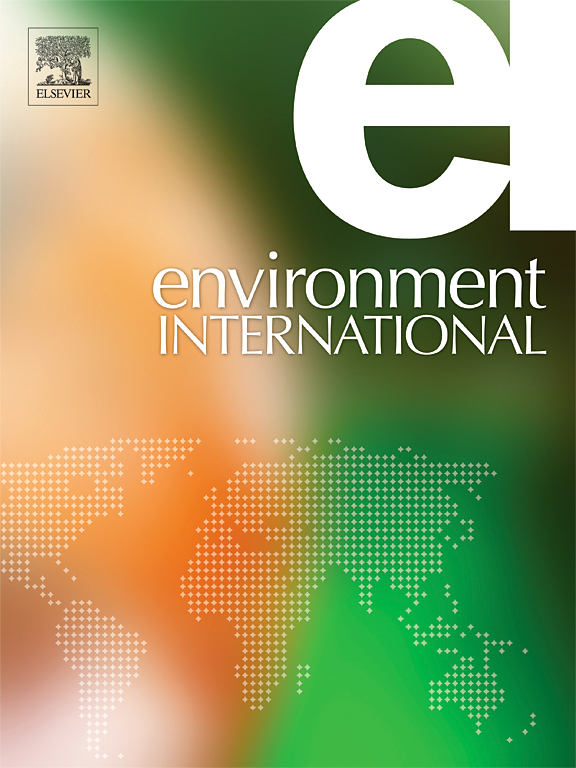Windows of susceptibility and joint effects of prenatal and postnatal ambient air pollution and temperature exposure on asthma and wheeze in Mexican children
IF 10.3
1区 环境科学与生态学
Q1 ENVIRONMENTAL SCIENCES
引用次数: 0
Abstract
Introduction
Prenatal and early-life exposure to air pollution and extreme temperatures are associated with childhood asthma and wheeze. However, potential windows of susceptibility and their sex-specific and interactive effects have not been fully elucidated. We aimed to identify critical windows of susceptibility and evaluate sex-specific effects in these associations, and evaluate exposure interactions.
Methods
We analyzed data from 468 mother–child pairs enrolled in the PROGRESS birth cohort in Mexico City. Daily residential levels of PM2.5, NO2, and temperature were generated from our validated spatiotemporally resolved models from conception to age 4 years. Childhood asthma and wheeze outcomes were collected at 4–6 and 7–8 years. Distributed lag nonlinear models (DLNMs) were used to identify susceptible windows for prenatal weekly-specific and postnatal monthly-specific associations of air pollution and temperature with respiratory outcomes adjusting for covariates. To evaluate sex-specific effects, DLNMs were stratified. Joint effects were assessed using relative excess risk due to interaction and attributable proportion.
Results
Mid-gestation was a critical window for both PM2.5 (weeks 20–28, cumulative OR: 1.18 [95% CI: 1.01, 1.37]; weeks 19–26, cumulative OR: 1.18 [95% CI: 1.02, 1.36]) and NO2 (weeks 18–25, cumulative OR: 1.16 [95% CI: 1.02, 1.31]) exposure, associated with higher odds of wheeze. Postnatal exposure to PM2.5 and NO2 during the first year of life was also linked to higher odds of wheeze. The warmer and colder temperatures showed mixed effects on respiratory outcomes. We observed a synergistic interaction between high PM2.5 and high temperature exposure during the first year of life, associated with higher odds of current wheeze. The associations of prenatal air pollution and temperature exposure with respiratory outcomes were more pronounced in males.
Conclusions
Early-life air pollution exposure contributes to the development of childhood asthma and wheeze, while exposure to temperature showed mixed associations with respiratory outcomes.


易感性窗口以及产前和产后环境空气污染和温度暴露对墨西哥儿童哮喘和喘息的共同影响
导言:产前和生命早期暴露于空气污染和极端温度与儿童哮喘和喘息有关。然而,潜在的易感性窗口及其性别特异性和交互影响尚未完全阐明。我们旨在确定易感性的关键窗口,评估这些关联中的性别特异性效应,并评估暴露相互作用。从受孕到 4 岁期间,每日居住地的 PM2.5、二氧化氮和温度水平均由我们经过验证的时空分辨模型生成。收集了 4-6 岁和 7-8 岁儿童哮喘和喘息的结果。分布滞后非线性模型(DLNMs)用于确定产前每周特异性和产后每月特异性空气污染和温度与呼吸系统结果相关性的易感窗口,并对协变量进行调整。为评估性别特异性效应,对 DLNMs 进行了分层。结果 妊娠中期是 PM2.5(第 20-28 周,累积 OR:1.18 [95% CI:1.01, 1.37];第 19-26 周,累积 OR:1.18 [95% CI:1.02, 1.36])和 NO2(第 18-25 周,累积 OR:1.16 [95% CI:1.02, 1.31])暴露的关键窗口期,与较高的喘息几率相关。出生后第一年暴露于PM2.5和二氧化氮也与较高的喘息几率有关。较高和较低的温度对呼吸系统结果的影响不一。我们观察到,出生后第一年接触高 PM2.5 和高温会产生协同作用,导致目前出现喘息的几率升高。结论早年的空气污染暴露会导致儿童哮喘和喘息的发生,而温度暴露与呼吸系统结果的关系不一。
本文章由计算机程序翻译,如有差异,请以英文原文为准。
求助全文
约1分钟内获得全文
求助全文
来源期刊

Environment International
环境科学-环境科学
CiteScore
21.90
自引率
3.40%
发文量
734
审稿时长
2.8 months
期刊介绍:
Environmental Health publishes manuscripts focusing on critical aspects of environmental and occupational medicine, including studies in toxicology and epidemiology, to illuminate the human health implications of exposure to environmental hazards. The journal adopts an open-access model and practices open peer review.
It caters to scientists and practitioners across all environmental science domains, directly or indirectly impacting human health and well-being. With a commitment to enhancing the prevention of environmentally-related health risks, Environmental Health serves as a public health journal for the community and scientists engaged in matters of public health significance concerning the environment.
 求助内容:
求助内容: 应助结果提醒方式:
应助结果提醒方式:


